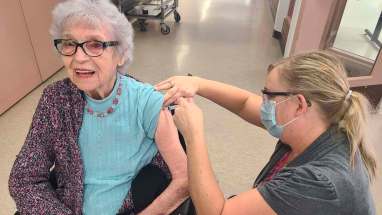Double-masking enters pandemic debate
Read this article for free:
or
Already have an account? Log in here »
To continue reading, please subscribe:
Monthly Digital Subscription
$0 for the first 4 weeks*
- Enjoy unlimited reading on winnipegfreepress.com
- Read the E-Edition, our digital replica newspaper
- Access News Break, our award-winning app
- Play interactive puzzles
*No charge for 4 weeks then price increases to the regular rate of $19.00 plus GST every four weeks. Offer available to new and qualified returning subscribers only. Cancel any time.
Monthly Digital Subscription
$4.75/week*
- Enjoy unlimited reading on winnipegfreepress.com
- Read the E-Edition, our digital replica newspaper
- Access News Break, our award-winning app
- Play interactive puzzles
*Billed as $19 plus GST every four weeks. Cancel any time.
To continue reading, please subscribe:
Add Free Press access to your Brandon Sun subscription for only an additional
$1 for the first 4 weeks*
*Your next subscription payment will increase by $1.00 and you will be charged $16.99 plus GST for four weeks. After four weeks, your payment will increase to $23.99 plus GST every four weeks.
Read unlimited articles for free today:
or
Already have an account? Log in here »
Hey there, time traveller!
This article was published 11/02/2021 (1762 days ago), so information in it may no longer be current.
People shouldn’t necessarily rush to double up in the wake of a recent U.S. study suggesting wearing two layered face masks offers more protection from potentially infectious aerosols, local experts say.
The Centers for Disease Control and Prevention reported Wednesday on a CDC experiment that used two artificial heads, set 1.8 metres (six feet) from each other. It found wearing one mask blocked around 40 per cent of air particles directed at it from the other head; wearing a cloth mask on top of a surgical mask blocked around 80 per cent.
If both heads are double-masked, around 95 per cent of such particles were blocked, the CDC said.
Acting deputy chief provincial public health officer Dr. Jazz Atwal said Thursday the province would hold off on recommending double-masking until further evidence was presented.
“There’s new evidence that comes out at a regular basis, and public health does its due diligence to look at that evidence,” he said.
“So at this point, we aren’t looking at changing our recommendation at all, but we will be continuing to review evidence and provide the best guidance for Manitobans based on that evidence.”
While the experiment has received international intention, Winnipeg infectious disease expert Dr. Philippe Lagacé-Wiens said he’s not fully convinced it’s time to reach for a second mask.
“We don’t have any proof that that double-masking actually reduces the transmission of COVID-19,” he said Thursday.
“There’s a natural thought that if it reduces the amount of spray that you’re getting out of the dummy, that it would probably reduce the risk of transmission, but that’s not actually proven yet.”
Lagacé-Wiens noted it was a lab-based study with simple variables — the two heads were dummies, only a small variety of masks were tested — and “doesn’t come close” to answering the specifics of how people could effectively layer masks.
“These are dummies. There are hundreds of thousands of different types of faces out there… It only really gives a tiny little perspective of what might be good,” he said. “What we really need, if we want to prove it’s effective, we need to follow that up with bigger studies, different masks.”

The CDC acknowledged the limitations of the study, but suggested double-masking may be beneficial because wearing two such coverings tightens gaps around the edges of a mask that may let in aerosols.
Lagacé-Wiens said the public should take the results as an opportunity to make sure personal masks are fitting properly.
“I think one of the big take-home messages for me from that study isn’t so much double-masking is essential, as let’s really work hard on getting good fitting on masks,” he said.
“We all know part of the problem, part of the conversation we should be having still, is you should be wearing a mask, there’s still a lot of resistance to that, trying to fine-tune that is really secondary.”
Epidemiologist Cynthia Carr said people should also be looking at the quality of the masks they’re currently using, and using them consistently in situations where people are closely interacting, before jumping to double-masking.
“The most important with the masks are that we’re wearing them consistently, and that we wear a mask with a good fit,” she said.
“Consistently means you should really even be considering that if you have guests in your home — of course, limiting to what the rules are — just remembering spread happens everywhere, regardless of whether you’re in your home, or in the library, or in the mall.”
There is some inherent benefit to double-masking, if people are doing it to close any gaps that reach would cause droplets to reach the nose and mouth, Carr said.

“Even just looking at getting the best of both worlds — getting the best benefit from the surgical mask, and then the better fit from a cloth mask that puts it more snugly on to your face, is a good idea,” she said.
“So I do think that there’s a benefit there, as long as they’re worn consistently.”
— with files from Kevin Rollason, The Associated Press
malak.abas@freepress.mb.ca
Twitter: malakabas_
wfppdf:https://wfpquantum.s3.amazonaws.com/pdf/2021/11161_mm7007e1-H.pdf | CDC study:wfppdf
Our newsroom depends on a growing audience of readers to power our journalism. If you are not a paid reader, please consider becoming a subscriber.
Our newsroom depends on its audience of readers to power our journalism. Thank you for your support.




